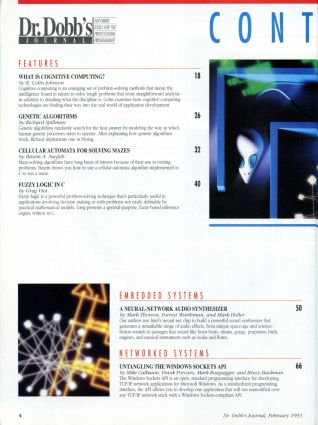
p.8 EDITORIAL
[author : Jonathan Erickson] #Edito
TABLE OF CONTENTS
FEATURES
p.18 WHAT IS COGNITIVE COMPUTING?
[author : R. Colin Johnson]
Cognitive computing is an emerging set of problem-solving methods that mimic the intelligence found in nature to solve tough problems that resist straightforward analysis. In addition to detailing what the discipline is, Colin examines how cognitive computing technologies are finding their way into the real world of application development.
p.26 GENETIC ALGORITHMS
[author : Richard Spillman]
Genetic algorithms randomly search for the best answer by modeling the way in which human genetic processes seem to operate. After explaining how genetic algorithms work, Richard implements one in Prolog.
p.32 CELLULAR AUTOMATA FOR SOLVING MAZES
[author : Basem A. Nayfeh]
Maze-solving algorithms have long been of interest because of their use in routing problems. Basem shows you how to use a cellular-automata algorithm implemented in C to run a maze.
p.40 FUZZY LOGIC IN C
[author : Greg Viot]
Fuzzy logic is a powerful problem-solving technique that's particularly useful in applications involving decision making or with problems not easily definable by practical mathematical models. Greg presents a general-purpose, fuzzy-based inference engine written in C.
EMBEDDED SYSTEMS
p.50 A NEURAL-NETWORK AUDIO SYNTHESIZER
[author : Mark Thorson, Forrest Warthman, and Mark Holler]
Our authors use intel's neural-net chip to build a powerful sound synthesizer that generates a remarkable range of audio effects, from unique space-age and science-fiction sounds to passages that sound like heart beats, drums, gongs, porpoises, birds, engines, and musical instruments such as violas and flutes.
NETWORKED SYSTEMS
p.66 UNTANGLING THE WINDOWS SOCKETS API
[author : Mike Calbaum, Frank Porcaro, Mark Ruegsegger, and Bruce Backman]
The Windows Sockets API is an open, standard programming interface for developing TCP/IP) network applications for Microsoft Windows. As a standardized programming interface, the API allows you to develop one application that will run unmodified over any TCP/IP network stack with a Windows Sockets-compliant API.
EXAMINING ROOM
p.72 INSIDE THE WINDOWS MESSAGING SYSTEM
[author : Matt Pietrek]
All Windows applications depend on the Windows messaging system, and understanding how the system works is fundamental to writing powerful Windows programs. Matt provides a detailed look at this complex, not fully documented area of Windows, and presents pseudocode for key routines.
PROGRAMMER'S WORKBENCH
p.82 NEURAL NETS FOR PREDICTING BEHAVIOR
[author : James F. Farley and Peter D. Varhol]
An off-the-shelf neural-network package is used to build a software model that takes sensor input and predicts wind speed and direction as output. Along the way, it solves problems like noisy data.
COLUMNS
p.105 PROGRAMMING PARADIGMS
[author : Michael Swaine]
Michael wraps up his two-part conversation with Stephen Wolfram, developer of Mathematica. This month, they discuss science, programming, business, and why some mathematicians don't like Stephen.
p.111 C PROGRAMMING
[author : Al Stevens]
This month AI looks at D-Flat++'s Application, Control, and textBox window classes, then compares the Source code for these modules with the Source code for the same features.
p.119 STRUCTURED PROGRAMMING
[author : Jeff Duntemann]
Jeff decides it's time to talk about intelligently managing data, noting that structured languages are particularly weak at data management. He then shares his notions of good database design.
p.127 GRAPHICS PROGRAMMING
[author : Michael Abrash]
Michael continues his foray into dirty-rectangle animation, a technique capable of producing animation of very high visual quality without help from video hardware or extra, nondisplayed video memory. This month's assembly language implementation of low-level drawing routines really boosts performance.
p.131 PROGRAMMER'S BOOKSHELF
[author : Ray Duncan]
There's a passel of recent books on navigating the Internet, and Ray examines three of them: Zen and the Art of the Internet, The Whole Internet User's Guide, and A Directory of Electronic Mail Addressing and Networks.
FORUM
p.10 LETTERS
[author : you]
p.152 SWAINE'S FLAMES
[author : Michael Swaine]
PROGRAMMER'S SERVICES
p.146 OF INTEREST
[author : Tami Zemel]

